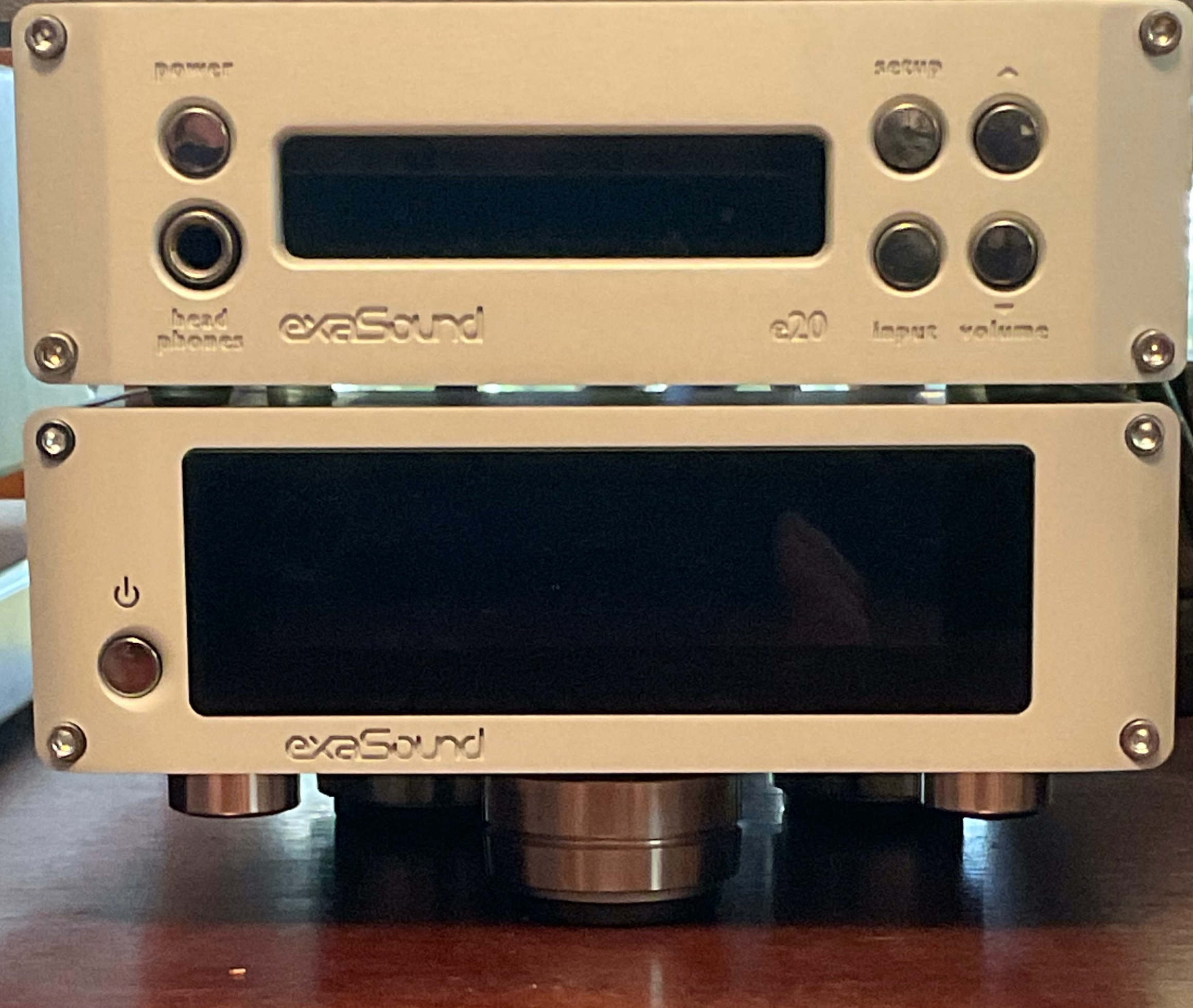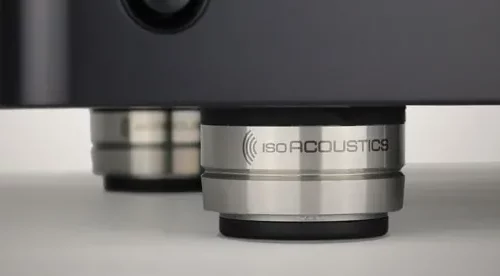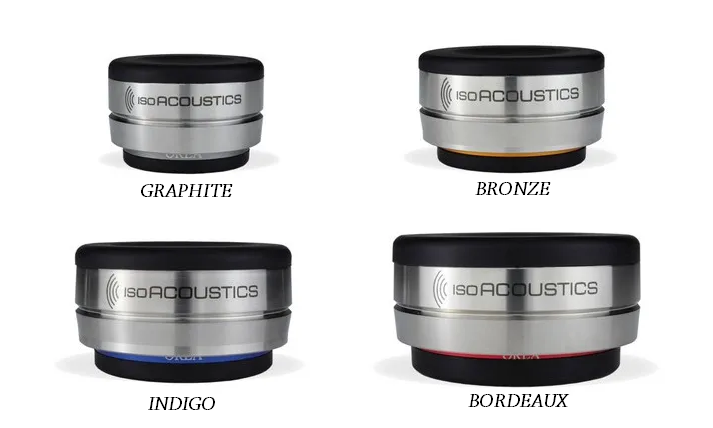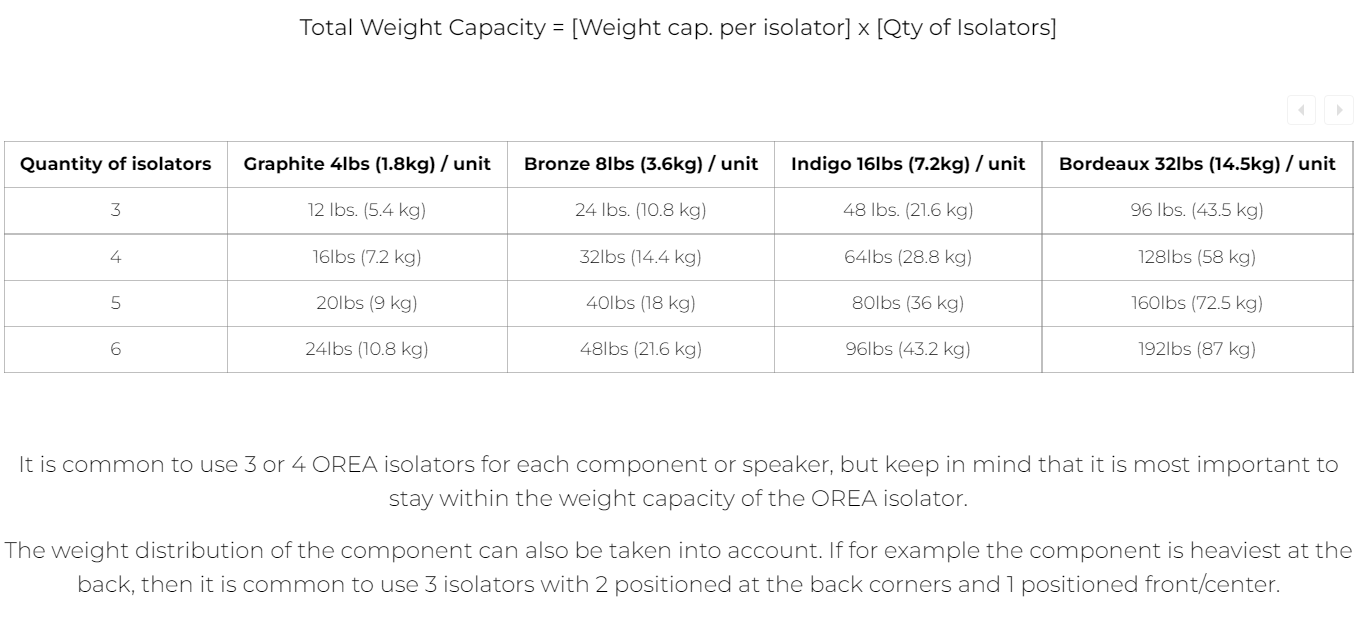IsoAcoustics Orea Graphite Isolators
Review by Jamie Gillies
As part of my quest in search of, to use poet Garrett Hongo’s great term from his recent memoir about audio obsession, “the perfect sound,” I began to consider isolation devices and products over the last couple of years. There are two schools of thought with respect to isolation. The first is that as sound travels out of a speaker, it obviously creates vibration and that can affect the performance of your system. That includes the speakers themselves and everything from components to cabling to the walls of your room. It is often the last piece of the puzzle for a budding audiophile: room treatments, an audiophile rack for components, and then isolation for speakers. The second is that the components themselves vibrate and have, in the cases of turntables and transports, moving parts. These can affect the sound.
My sound room does not have an audiophile rack. Instead, I have my components along an 8 foot long teak sideboard, largely for aesthetic reasons. So when I suggested that perhaps IsoAcoustics, a Canadian company that creates individual isolation as opposed to racks or stands, might be a good place to start, they sent Wall of Sound three sets of products to try.
I decided to first review the Orea Series Audio Component Isolators (the other two reviews are complete and will be posted separately). These puck-shaped isolators sit underneath components to provide better stabilization and to reduce vibration. The intended goal is to isolate amplifiers, DACs, transports and turntables “resulting in greater sound clarity and focus.”
I wanted to try the Oreas specifically under my exaSound e20 DAC and PlayPoint streamer. This is the heart of my system as nowadays I stream most of my music. The Oreas are sized based on the weight of your components and come in four distinct versions: Graphite for up to 4 pounds, Bronze for up to 8 pounds, Indigo for up to 16 pounds, and Bordeaux for up to 32 pounds. They can be used in combinations of either three or four Orea pucks. So, for example, if you have a component that weighs 16 pounds, you would ideally use four Graphite pucks underneath the gear, since each Orea Graphite can handle 4 lbs. My DAC and streamer combination weighs only about ten pounds including the additional weight of a solid state external hard drive, so I chose three Orea Graphite isolators to place underneath the components.

Set up is easy but may require some trial and error. For larger components, it is likely easier to balance the Orea pucks because you simply set them up adjacent to the original feet. But for my streamer and DAC, I considered where the most weight would be located, since it is not evenly distributed. After some movement, I settled on a triangular configuration, with two pucks towards the back and one in the middle at the front to provide the most stability.
Critical Listening
I decided to try three different ways to hear any potential changes in the sound. I first began with a baseline before using the Oreas. I selected five tracks that I know well, and listened to them repeatedly through the headphone jack of the DAC, then through the headphone jack of my preamplifier, and then finally through my speakers. My headphones are pretty basic: Bose QuietComfort 35s. I use them in audio simply to get a baseline, not as critical listening, since I do not own a headphone amplifier nor do I use headphones much. But headphones provide a good way to give me an A/B test with the isolators since I can hear subtle differences between the source with or without them. I can then listen for differences when music is played through my speakers. My summary below is based on the sound from my speakers, but they parallel what I heard from the headphones.
The five tracks I used were The Tennessee Waltz by Holly Cole from her Don’t Smoke In Bed album (Analogue Productions SACD DSD), This Town by Patricia Barber from her Clique! album (Impex/NativeDSD DSD256), So What by Miles Davis from Kind Of Blue (Columbia/HDtracks 24/192), Gravity by John Mayer from Continuum (Aware/Columbia/HDtracks 24/96), and Sailing To Philadelphia by Mark Knopfler, in a duet with James Taylor, from Knopfler’s Sailing To Philadelphia (Mercury FLAC). Each of these tracks I know very well and I also know the limitations of my components with them.


 With Holly Cole and Patricia Barber, my gear tends to emphasize the sibilance in their voices to the point where it can become a distraction. I noticed a very slight improvement on Holly Cole’s voice where the almost lispy sibilance relaxed, but it clearly was still there with the Oreas under my streamer. Patricia Barber sounded better, with the extended highs sounding more natural in comparison to how it sounded with no isolation. But the effect was fairly minimal. With Miles Davis, there was more detail on both Coltrane’s tenor and Cannonball Adderley’s alto before Davis’s trumpet takes over. I did detect some more background noise as well, such as more of the original hiss on the master tape. So there was an effect but how much the isolators improved it was unclear.
With Holly Cole and Patricia Barber, my gear tends to emphasize the sibilance in their voices to the point where it can become a distraction. I noticed a very slight improvement on Holly Cole’s voice where the almost lispy sibilance relaxed, but it clearly was still there with the Oreas under my streamer. Patricia Barber sounded better, with the extended highs sounding more natural in comparison to how it sounded with no isolation. But the effect was fairly minimal. With Miles Davis, there was more detail on both Coltrane’s tenor and Cannonball Adderley’s alto before Davis’s trumpet takes over. I did detect some more background noise as well, such as more of the original hiss on the master tape. So there was an effect but how much the isolators improved it was unclear.
 With John Mayer, there was a clear effect. His voice did smooth out and improve, but not enough to make this track audiophile-like. Mayer’s album is often praised for its excellent production but I have found that, while it is a better recorded pop album than most, its limitations start to appear the more you lower the noise floor of your equipment. It seems to be one of those recordings that sounds best as a CD as opposed to a higher resolution format.
With John Mayer, there was a clear effect. His voice did smooth out and improve, but not enough to make this track audiophile-like. Mayer’s album is often praised for its excellent production but I have found that, while it is a better recorded pop album than most, its limitations start to appear the more you lower the noise floor of your equipment. It seems to be one of those recordings that sounds best as a CD as opposed to a higher resolution format.
 So far, I was not hearing a leaps and bounds change in sound with these isolators. Finally, after A/Bing these four tracks a lot and noticing these subtleties, I listened to Mark Knopfler and James Taylor. Instantly, with the isolators back underneath, that particular track snapped into focus like a veil was lifted on the recording. It sounded fantastic, definitely better than I had ever heard it.
So far, I was not hearing a leaps and bounds change in sound with these isolators. Finally, after A/Bing these four tracks a lot and noticing these subtleties, I listened to Mark Knopfler and James Taylor. Instantly, with the isolators back underneath, that particular track snapped into focus like a veil was lifted on the recording. It sounded fantastic, definitely better than I had ever heard it.
It occurred to me what might be happening. By isolating the DAC and streamer, non-audiophile recordings had a noticeable change or improvement but my audiophile tracks did not change as much. I next A/B’ed a sampling of albums by Billie Eilish, Taylor Swift, The Black Keys and Beck, all with fairly low dynamic ranges and with a fairly typical mix of modern production and mastering. What I found was that on these recordings, there was a cleaner soundstage, more holographic and musical, with the Oreas placed underneath. While I was not stunned by the improvement, the Oreas definitely did what they promised to do.
Initial Verdict
For isolators that start at about $55 each, this is a worthwhile tweak for those trying to get even more out of their equipment. I suspect the improvement under, say, an inexpensive CD player or a headphone amplifier, would be immediately noticeable. With higher end equipment, which often has extensive built-in isolation, I think that Oreas would be very much dependent on the gear.
I wanted to see how they would perform after reviewing other IsoAcoustics products, and in combination with a full loom of isolators. So I deliver an initial verdict that these are a worthwhile tweak for my mid-priced equipment. But I will finish the review with how they sound adjacent to the other isolation devices.
Final Verdict
In association with the zaZen platforms and Gaia isolators for the speakers, the IsoAcoustics loom of products provided a clear and significant improvement in sound quality. Keeping in mind that my equipment is mid-level, the IsoAcoustics products provided as significant an improvement as better cables. That surprised me how much isolation improved the sound. There is definitely something to it. For those more skeptical, think of it as how a properly isolated and balanced turntable sounds versus one that is not perfectly flat. You are going to hear a difference in quality. The difference may be more minute and incremental, but IsoAcoustics has found a way to offer isolation free of the bulkiness and cost prohibitive audiophile racks and stands that can cost thousands of dollars. The Orea isolators are a bargain for those looking for an improvement, especially with digital sources and preamplifiers.
Features/Specs:
https://isoacoustics.com/home-audio-isolation-products/orea-series/
- The Orea Series is geared towards the home audio and audiophile market. IsoAcoustics also have the Pro Series, which is geared more towards the Pro market, and within that market there is usually a preference for the black colour which is less visible and distracting in a control room.
- Technically both series are virtually identical in terms of design and performance. The only consideration is the weight of the product to be isolated.
- The Puck Series is steel construction with black powder coat, while the Orea Series are stainless steel construction.
- Both have suction-cup coupling on the top and bottom of the isolators. The Iso-Puck was originally designed for the pro audio and Musical Instrument (MI) channel, and used with studio monitors, guitar/bass amps, DJ turntables, etc. The Orea, on the other hand, is designed for home audio.
- The performance curve for the Orea models are narrower in weight range and will provide a slightly stronger sonic benefit in its range than the Iso-Pucks. The more effective isolation results in more sound clarity and focus.
- The OREAs are sold individually and feature IsoAcoustics’ patented isolation design which manages the energy from the component and provides isolation from external vibrations.
- IsoAcoustics recommends positioning the Oreas directly underneath the chassis of a turntable or component and not underneath the existing feet so that the weight is applied over the entire top surface of the Orea and not concentrated on a small section of the Orea.
- Orea Series include Graphite for up to 4 pounds, Bronze for up to 8 pounds, Indigo for up to 16 pounds, and Bordeaux for up to 32 pounds.





I have a Playpoint streamer and e32MkII DAC. I tried IsoAcoustics mini-pucks under the feet and directly under the chassis and was not satisfied. I believe in using the component’s feet, so I placed an old Target shelf under the components and on top of four minipucks. That delivered the sonic upgrade I had hoped for. I then tried with three minipucks, since the exaSound gear is quite light. Again, I heard a significant improvement. Give it a try. If you don’t have an actual audiophile shelf like the Target, then maybe any light shelf could substitute (e.g. balsa wood, etc.)
The truth is anything you put under gear will change the response of the gear. Try 4 hard apples under say your preamp or source and I guarantee you will hear a difference, my point is there is no magic in these weeks, anything you put under gear changes the sound even the type of stand you use, So, in the end, we all listen to colorations no matter what we do, it became if you like that change or not.
Apples rot. Look up medical vibration control to understand it better.
Happy new year!